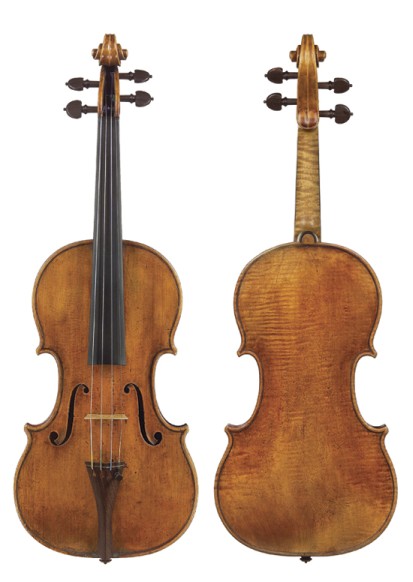| The violin was
officially designed by Andrea Amati, an Italian lute maker. Amati
was asked to build the violin as a lighter alternative to the lyre, in
the 1500s. It was a stringed instrument, comprising four strings tuned a
fifth apart. It is the smallest and highest-tuned member of the violin
family of string instruments, which also includes the viola, cello and
double bass.
There were changes to the structure during the following years. Stradivarius enlarged the body size a little and used bolder holes, producing a stronger sound. During the C19th, the bridge was heightened, and the curvature was increased to increase volume. The increased height, and a change to 440Hz as a standard, necessitated stronger bass bars. Fingerboards were also extended to enable much higher pitches to be played. It is during this century that chin rests were added. The original gut strings, which produced a warm mellow tone, were gradually replaced by metal strings. It is not easy to appreciate the development in and differences between these early and iconic instruments, as many of the changes were subtle alterations in shape and 'thicknessing' of the domes. However they remain the basis for many of the currently manufactured instruments, which are frequently based on the form of a celebrated model by one of these makers. |
||||||
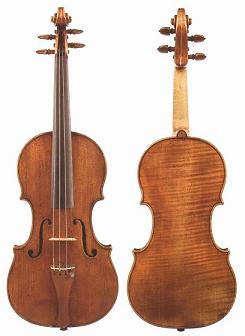 |
 |
Among the many makers bearing the
Amati name, the following ,uthiers are considered outstanding:
Andrea (Cremona, Italy, 1525-1611) is known as the founder of the great Cremonese school of violin making, after making viols and rebecs. Instruments dated after 1584 are said to be the work of his sons Antonius and Hieronymus, and instruments known to be by Andrea are not numerous. I Antonio (1560-1649) and Hieronymus (1562-1630), sons of Andrea, made instruments jointly and separately, and are thought to have succeeded their father at the French court. Their instruments show good workmanship and have agreeable tonal qualities but are not in the realm of "great." Nicolo (1596-1684), son of Hieronymus, grandson of Andrea, and nephew of Antonio, is considered the greatest instrument maker of the family. His instruments are much admired for their beautiful and penetrating, though not powerful, tone. Violins, violas, cellos, several three-string bass viols, and at least one pochette by his hand are known.
|
||||
| Niccolo Amati 1640 | Amati violin 1574 | |||||
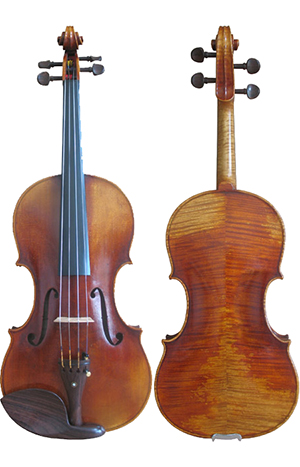 |
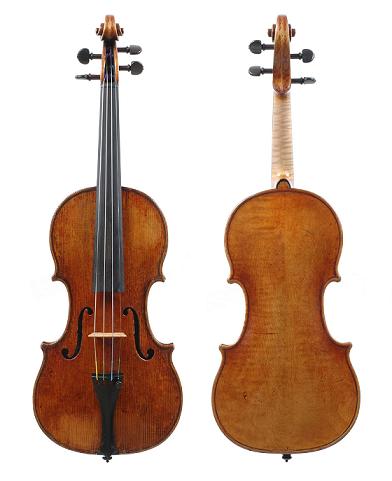 |
Guarneri
(or Guarnieri) is the family name of a group of highly acclaimed
violin makers from Cremona in Italy from the 17th and 18th centuries,
whose standing is considered to be alongside the Amati and Stradivari
families, though the exact Guarneri family's history may be somewhat
uncertain.
Andrea Guarneri (1626-1698) was an apprentice in the Amati workshop with Antonio Stradivari. * Andrea's sons, notably including Pietro Giovanni Guarnieri (1666-1740), continued the father's traditions. * The second son of Andrea, Giuseppe Guarneri (1666-1740?) made instruments in Cremona and was father to two other instrument makers: Pietro Guarneri (Peter of Venice), (1695-1762), moved to Venice about 1720 and adopted Venetian techniques into his own violin making. Bartolomeo Giuseppe Antonio Guarnieri, also known as Joseph (Giuseppe) (1698-1744), has been called the finest violin maker of the Amati line. Giuseppe is known as del Gesu because his labels always incorporated the characters I.H.S.and a Roman cross. His instruments deviated significantly from family tradition, becoming uniquely his own style, and are considered second in quality only to those of Stradivari and argued by some to be superior. |
||||
| Giuseppe Guarneri 1742 | Andrea Guarneri Cremona violin 1673a | |||||
|
|
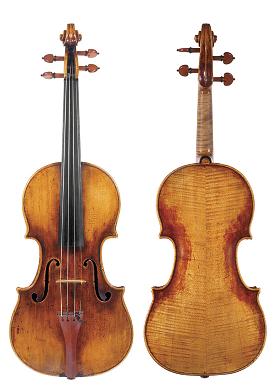 |
Antonio Stradivari (1644? -
December 18, 1737) was an Italian luthier, the most prominent member of
that profession. He was born in the year 1644 (by some sources also in
1649 or 1650) in Cremona, Italy to Alessandro Stradivari and Anna Moroni.
Probably in the years 1667 through 1679 he served as a pupil in Amati's
workshop.
He set up his own workshop in the Piazza San Domenico in 1680, and soon established his fame as a instrument-maker. He began to show his originality, making alterations in Amati's model. The arching was improved, various degrees of thickness in the wood were more exactly determined, the formation of the scroll altered, and the varnish more highly coloured. His instruments are recognized by their inscription in Latin: Antonius Stradivarius Cremonensis Faciebat Anno [date] (Antonio Stradivari, Cremona, made in the year ...). It is generally acknowledged that his finest instruments were manufactured from 1698 to 1725 (peaking around 1715), exceeding in quality those manufactured between 1725 and 1730. After 1730, some of the instruments are signed sub disciplina Stradivarii, and were probably made by his sons, Omobono and Francesco. Including violins, Stradivari is thought to have made more than 1,100 instruments in all. About 650 of these instruments survive today. Antonio Stradivari died in Cremona, Italy on December 18, 1737 and is buried in the Basilica of San Domenico in Cremona. |
||||
| Lady Tennant Stradivarius | Stradivarius 1725 | |||||
